Documents: Go to download!
User Manual
- User Manual - (English, French, Spanish)
- Energy Guide - (English)
User manual Washer
Installation
Follow these instructions carefully to ensure proper installation of your washer and to prevent accidents when using it.
WARNING: Certain internal parts are intentionally not grounded and may present a risk of electric shock only during servicing. Service personnel – Do not contact the following parts while the appliance is energized: Control board, heat sink, motor, inlet valve, heater and pump.
Unpacking your washer
- Unpack your washer and inspect it for shipping damage. Make sure you have received all the items shown on the next page. If your washer was damaged during shipping, or you do not have all of the items
- To prevent personal injury or strain, wear protective gloves whenever lifting or carrying the unit.
- WARNING: Packing materials can be dangerous to children; Keep all packing material (plastic bags, polystyrene, etc.) well out of children’s reach.
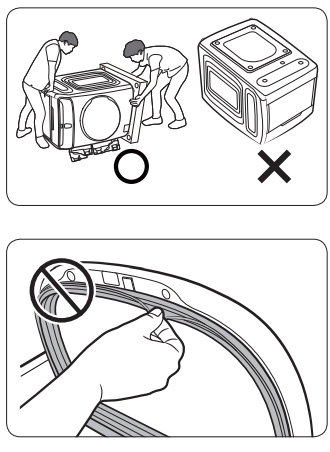
CAUTION
- When unpacking the washer, a 2 person collaboration is needed. To remove the cushion bottom of the packing materials, do not tip the washer over on its front. When you lay the washer down to remove the carton base, protect the sides of the washer and lay it down carefully. Never lay your washer on its back or front.
- Do not yank out or remove the sealing of the inner door. This may cause a leak during the washing process.
What’s included
Make sure all the parts are included in the product package. If you have a problem with the washer or the parts, contact the Samsung customer care center or the retailer
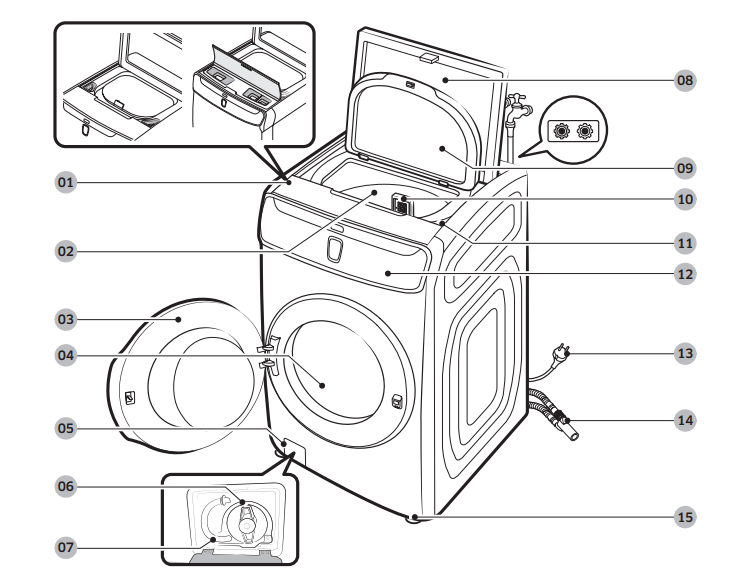
01 Lower detergent compartment
02 Tub
03 Front door
04 Drum
05 Filter cover
06 Pump filter
07 Emergency drain tube
08 Top door
09 Protective cover (inner)
10 Lint filter
11 Upper detergent compartment
12 Main panel
13 Power plug
14 Pipe connector (Upper drain hose & lower drain hose)
15 Levelling legs
Accessories (supplied)

* When not using the pedestal, use the rubber cups for soft floors or surfaces.
Accessories (not supplied)
You must purchase these items at a local service center

NOTE
- The number (7 to 9) of bolt caps provided depends on the model.
- The appearance of the washer and provided accessories may differ by model.
- To purchase an accessory or lost part, contact a local Samsung service center or your retailer.
CAUTION
- Make sure to use the dedicated pedestal to the flex system, “WE272N”. Not using the dedicated pedestal may cause safety concerns.
- Do not reuse old water hoses, which may leak or burst, causing flooding and/or property damage.
- Make sure rubber washers are inserted in each coupling of both water hoses.
Tools needed for installation (not supplied)

Installation requirements
Electrical supply and grounding
- AC 120 V / 60 Hz / 15 AMP fuse or circuit breaker is required.
- Use an individual branch circuit. Connect only the washer to the circuit.
WARNING
- Do NOT use an extension cord.
- Use only the power cord that comes with the washer.
- Do NOT connect the ground wire to plastic plumbing, gas lines, or hot water pipes.
- Improperly connected grounding conductors may cause electric shock.
- To ensure proper grounding, the washer comes with a power cord featuring a three-prong grounding plug for use in a properly installed and grounded outlet. Check with a qualified electrician or service person if you are not sure about the grounding.
- Do not modify the provided plug. If it does not fit the outlet, call a qualified electrician to install a proper outlet.
- To prevent unnecessary risk of fire, electrical shock, or personal injury, all wiring and grounding must be done in accordance with local codes, or in the absence of local codes, in accordance with the National Electrical Code, ANSI/ NFPA No. 70-Latest Revision (for the U.S.) or the Canadian Electrical Code CSA C22.1 – Latest Revisions and local codes and ordinances. It is your responsibility to provide adequate electrical service for your washer.
Water supply: Water pressure less than 20 psi (137 kPa) may cause the water valve not to close completely. Or, it may take longer to fill the drum, causing the washer to turn off. Taps must be within 4 feet (122 cm) from the rear of the washer so that the provided inlet hoses reach the washer. To reduce the risk of leaks:
- Make sure taps are easily accessible.
- Turn off the taps when the washer is not in use.
- Check for any leaks at the water inlet hose fittings on a regular basis.
CAUTION: Before using the washer for the first time, check all connections at the water valve and taps for any leaks.
Drain: Samsung recommends a standpipe 18 in (46 cm) high. The drain hose must be connected through the hose clip to the standpipe, and the standpipe must fully cover the drain hose.
Flooring:
- For best performance, the washer must be installed on a solid floor. Wood floors may need to be reinforced to minimize vibration and/or unbalanced loads. Carpeting and soft tile surfaces do not provide good resistance to vibrations and may cause the washer to move slightly during the spin cycle.
- CAUTION: Do NOT install the washer on a platform or a poorly supported structure.
Water temperature: Do not install the washer in areas where water may freeze as the washer always retains some water in its water valves, pumps, and/or hoses. Frozen water left in the connection parts may cause damage to belts, the pump, and other components of the washer.
Alcove or closet installation
Minimum clearance for stable operation:
- Sides 1 in. (25 mm)
- Rear 6 in. (152 mm)
- Top 21 in. (533 mm)
- Front 2 in. (51 mm)
If both the washer and a dryer are installed in the same location, the front of the alcove or closet must have two unobstructed air openings for a combined minimum total area of 72 in² (465 cm²). Your washer alone does not require a specific air opening.
Installation on a pedestal
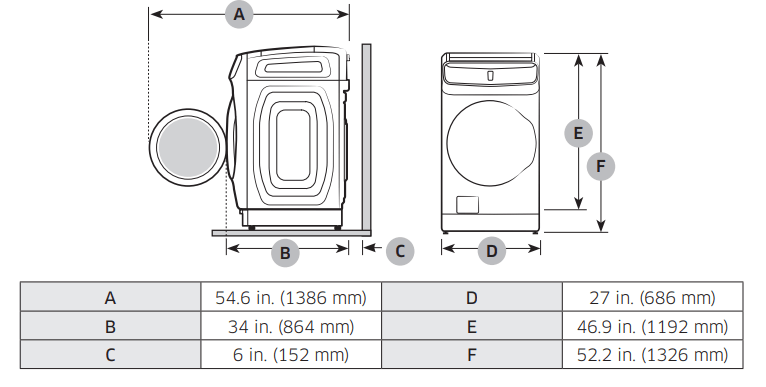
Side by side installation

*This clearance is not applicable to standalone washers.
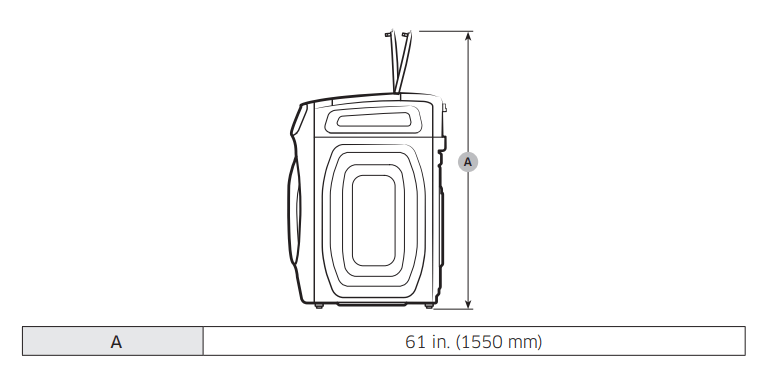
Step-by-step installation
STEP 1 Select a location - Location requirements:
- A solid, level surface without carpeting or flooring that may obstruct ventilation
- No direct sunlight
- Adequate room for ventilation and wiring
- Ambient temperature always higher than the freezing point (32 °F / 0 °C)
- A way from heat sources
STEP 2 Remove the shipping bolts
WARNING
- Packaging materials can be dangerous to children. Dispose all packaging material (plastic bags, polystyrene, etc.) out of children’s reach.
- To ensure proper installation, all 7 shipping bolts must be removed.

Unpack the product package and remove all shipping bolts (x7).
- Loosen all shipping bolts on the rear of the machine using the wrench. NOTE An adjustable wrench or 10 mm openend wrench is required for removing the shipping bolts.
- Fill the holes with the supplied plastic bolt caps. Keep the shipping bolts for future use.
STEP 3 Adjust the levelling legs
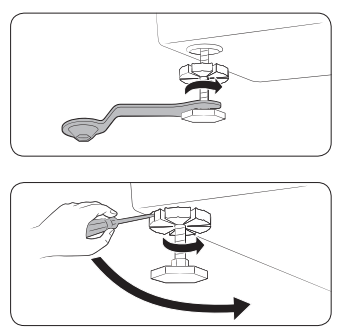
- Gently slide the washer into position. Excessive force may damage the levelling legs.
- Level the washer by manually adjusting the levelling legs.
- When levelling is complete, tighten the nuts using the wrench.
NOTE An adjustable wrench or 17 mm openend wrench is required to loosen or tighten the leveling legs.
STEP 4 Put the rubber cups on the legs (Only for soft floor or surface)
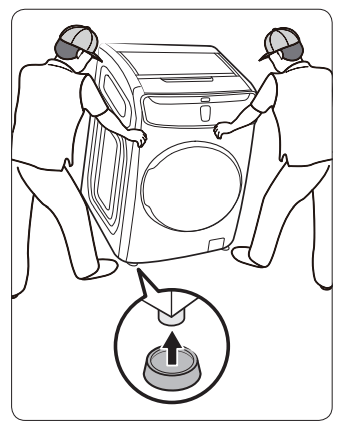
To protect a soft floor or surface, use the provided rubber cups. You don’t need to use the rubber cups on a hard floor or on a pedestal.
- Let two or more persons hold both sides of the washer.
- While slanting the washer to one side, put the rubber cups under each leg of the washer one by one.
CAUTION Make sure you have two or more persons insert the rubber cups. Otherwise, the washer may fall, causing physical or property damage.
STEP 5 Connect the water hoses
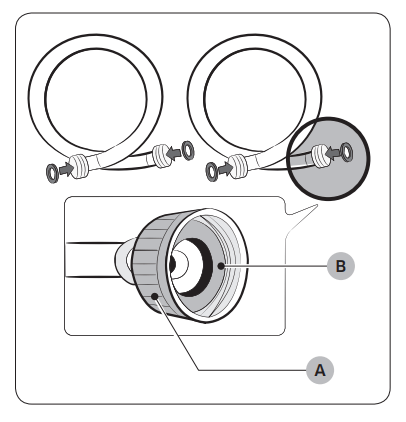
CAUTION
- Make sure you use a new water hose and that there are rubber gaskets (B) inside the couplings (A) at either end of each water hose. A water hose without the gasket may leak.
- If there is a water leak, stop using the washer and contact a local Samsung service center. A water leak may cause electric shock.
- Do not stretch the water hose by force. If the hose is too short, replace the hose with a longer, high-pressure hose.
- To prevent leaks, make sure both water hoses are not bent or kinked. A water leak may cause electric shock.
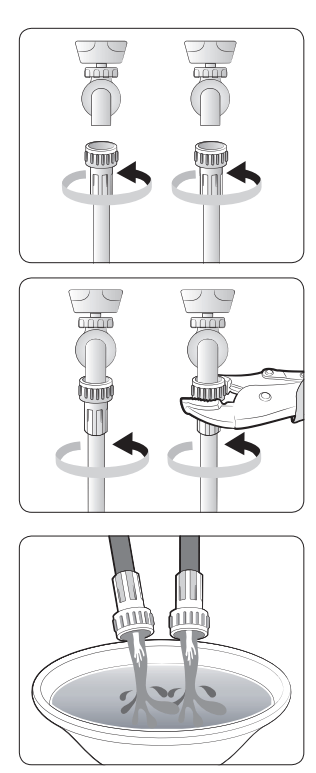
To connect the water hoses to the taps:
- Connect one end of each water hose to the Hot or Cold tap.
- Turn the fittings by hand until they are tight, and then tighten them an additional two-thirds of a turn with a pliers. To prevent damage, do not overtighten the fittings.
- When done, pull the water hoses up and down to check if they are properly connected.
- Put the other ends of the hoses into a bucket and open the taps for 10-15 seconds to remove impurities. When done, close the taps.

- Connect the other ends of the water hoses to the corresponding inlets on the rear of the machine as specified. Make sure the hot water hose is connected to the hot inlet, and the cold water hose to the cold inlet.
- Repeat step 2 above on the other fittings. Make sure both water hoses are connected properly. See the ‘4C’ information code for troubleshooting.
- Open both taps, and then check if there is a leak.
CAUTION: To prevent water hoses from being bent or kinked, make sure there is at least a 6-inch (150 mm) space between the washer and the rear wall.
NOTE: If you do not want to use hot water, insert the inlet cap into the hot water inlet. You must purchase the inlet cap. If the hot water inlet is closed with the inlet cap, you must select Cold for the water temperature. All other water indicators turn off.
STEP 6 Position the drain system
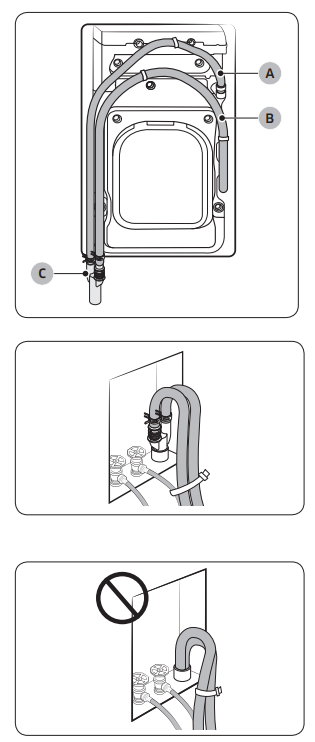
The pipe connector is attached on the product.
NOTE
A : Upper drain hose
B : Lower drain hose
C : Pipe Connector
In a wall standpipe drain system
- The drain hose must be placed into a wall standpipe drain system.
- After inserting 2 drain hoses into the pipe connector, use tie straps to bind the drain hoses, and then insert the pipe connector into the wall standpipe.
- When complete, use the tie straps to bind the drain hose to the water hose.
WARNING: Make sure to use the pipe connector before inserting the drain hoses. Without the pipe connector, the drain hose will not be positioned securely inside the wall standpipe, causing a water leak.
The pipe connector can be positioned in the following ways:
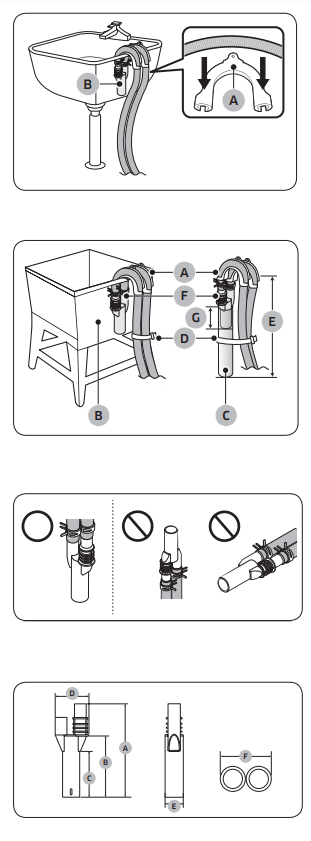
Over the edge of a wash basin
- The pipe connector (B) must be placed at a height of between 24 in. (60 cm) and 35 in. (90 cm) from the floor. To keep the spout of the drain hose bent, use the supplied plastic hose guide (A). Secure the guide to the wall using a hook to ensure stable drainage.
- NOTE - B : Pipe Connector
ln a standpipe or laundry tub
- The laundry tub (B) or standpipe (C) must be no shorter than 18 in. (46 cm) and no higher or longer than 96 inches (245 cm). Make sure the pipe connector and the standpipe are not airtight. The height of the standpipe (E) must be 43 in. (1100 mm) or higher from the floor.
- NOTE - A: Hose guide / D: Tie straps / F : Pipe Connector / G: 85 mm
CAUTION
- Do not extend the (Y-shaped) pipe connector using an extension hose.
- Make sure you face the tip of the pipe connector downwards to the drain hole. Positioning the connector tip elsewhere can cause the drained water to flow backward.
Dimensions of the pipe connector

To position without the pipe connector
If you do not use the pipe connector, each drain hose can be positioned in the following ways:

- Over the edge of a wash basin: The drain hose must be placed at a height of between 24 in. (60 cm) and 35 in. (90 cm) from the floor. To keep the spout of the drain hose bent, use the supplied plastic hose guide (A). Secure the guide to the wall using a hook to ensure stable drainage.
- ln a standpipe or laundry tub: The laundry tub (B) or standpipe (C) must be no shorter than 18 in. (46 cm) and no higher or longer than 96 inches (245 cm). Make sure the drain hose and the standpipe are not airtight. The height of the standpipe (E) must be 43 in. (1100 mm) or higher from the floor.
- NOTE - A: Hose guide / D: Tie straps
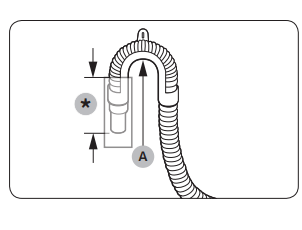
CAUTION
- Connect the hose guide (A) within 3–5 in. (7.6–12.7 cm)* from the end of the drain hose. If the drain hose is extended beyond the end of the hose guide, mold or microorganisms could spread inside the washer.
- The drain hose can be installed up to 96 in. (245 cm) high, but the draining capability can be reduced at the maximum height. Water remaining in the drain system may cause an odor.
- If the drain hose is installed less than 18 in. (46 cm) high, water can be drained during the process due to a siphon phenomenon. If this happens, a ‘4C’ information code appears on the display.
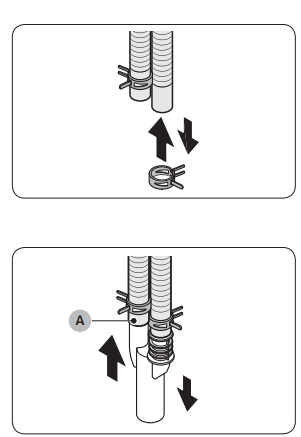
NOTE: To position using the pipe connector You washer comes with a pipe connector that is designed to join the upper drain hose and the lower drain hose. You can choose to use the connector to combine two drain hoses into a single outlet.
- Insert the clamp ring on the end of the drain hose, one for each drain hose.
- Insert the pipe connector into the drain hoses. Make sure the longer side (A) fits into the drain hose running from the lower washer.
- Fix the position of the clamp rings near the end of each hose.
- To remove the pipe connector, follow these steps above in the reverse order.
STEP 7 Final check and power on
- Before using your washer, make sure to remove the dehumidifying agent (silica gel) from inside the upper washer.
- Do not eat or swallow the dehumidifying agent (silica gel).
- The protective cover may form moisture on its surface after the washer has checked for a leak to ensure normal operation. This is normal, and does not indicate a defective part. Open the cover for a moment to remove the moisture.
- Plug the power cord into an AC 120 V / 60 Hz / 15 AMP approved electrical outlet protected by a fuse or circuit breaker. Then, press POWER to turn on the washer.
Before you start
Initial settings
Run calibration (recommended): Calibration ensures accurate weight detection by the washer. Make sure the tub or drum is empty before running Calibration.
To calibrate the upper washer
- Press POWER on the control panel of the upper washer to turn the washer on.
- Press and hold NORMAL and Temp. simultaneously for 3 seconds.
- Press START/PAUSE to start Calibration.
- The door is locked during the operation.
- The tub keeps rotating clockwise and counter clockwise for several minutes.
- When complete, the upper washer turns off automatically
To calibrate the lower washer
- Press POWER on the control panel of the lower washer to turn the washer on.
- Press and hold Temp. and Delay End on the lower washer control panel simultaneously for 3 seconds.
- Press START/PAUSE on the lower washer control panel to start Calibration.
- When complete, the lower washer turns off automatically.
NOTE: Instead of rotating the tub, the lower washer rotates the drum.
Laundry guidelines
STEP 1 Sort - Sort the laundry according to these criteria:
- Care label: sort the laundry into cottons, mixed fibers, synthetics, silks, wools, and rayon.
- Color: Separate whites from colors.
- Size: Mixing different sized items together in the tub improves washing performance.
- Sensitivity: Wash delicate items separately. For pure, new woollen items, curtains, and silk items, check the labels for washing instructions
NOTE: Make sure to check the care label on all clothing, and sort clothing accordingly before starting the wash.
STEP 2 Empty pockets
- Empty all the pockets of your laundry items
- Metal objects such as coins, pins, and buckles on clothing may damage other laundry items as well as the drum or tub.
- Turn clothing with buttons and embroideries inside out
- If pants or jacket zippers are open while washing, the drum or tub may be damaged. Zippers should be closed and fixed with a string.
- Clothing with long strings may become entangled with other clothes. Make sure to tie the strings before starting the wash.
STEP 3 Use a laundry net
- Brassieres (water washable) must be placed in a laundry net. Metal parts of the brassieres may break through and tear other laundry items.
- Small, light clothing such as socks, gloves, stockings, and handkerchiefs may become caught around the door. Place them inside a fine laundry net.
- Do not wash the laundry net by itself without other laundry. This may cause abnormal vibrations that could move the washer and result in injury.
STEP 4 Determine the load capacity
- Lower washer: Do not overload the washer. Overloading may cause the washer to wash improperly.
- NOTE: When washing bedding or bedding covers, the wash time may be lengthened or the spin efficiency may be reduced. For bedding or bedding covers, the recommended maximum spin level is “Low or Medium Spin”, and the load capacity is 3.0 kg or less.
- CAUTION: If the laundry is unbalanced and the “Ub” information code is displayed, redistribute the load. Unbalanced laundry may reduce the spinning performance.
Upper washer
- Laundry guidelines
- Use the upper washer for small loads under 3.3 lbs (1.5 kg)

NOTE
- Use the recommended load for optimal washing performance. Overloads may reduce the performance.
- Use the lower washer for stubborn or heavily soiled loads or loads larger than recommended.
STEP 5 Add the correct detergent type
The type of detergent depends on the type of fabric (cotton, synthetic, delicate items, wool), color, wash temperature, and degree of soiling. Always use “low suds” HE laundry detergent which is designed for automatic washers.
NOTE
- Follow the detergent manufacturer’s recommendations based on the weight of the laundry, the degree of soiling, and the hardness of the water in your local area. If you are not sure about the water hardness, contact your local water authority.
- Do not use detergent that has hardened or solidified. This detergent may remain after the rinse cycle, blocking the drain outlet
Use HE detergent only

Your washer is designed to use high efficiency (HE) detergents.
- For the best cleaning results, use a high efficiency detergent such as Tide HE, Wisk HE, Cheer HE or Gain HE*. High efficiency detergents contain suds suppressors that reduce or eliminate suds. When fewer suds are produced, the load tumbles more efficiently and cleaning is maximized. (*Brand names are trademarks of their respective manufacturers.)
WARNING: Regular detergent is not recommended. Use HE detergents only.
Guide to cleaning agents
Upper washer

The upper washer provides two cleaning agent compartments: the left-side compartment for bleach, and the right side for fabric softener. You can apply detergent manually into the tub using the provided Aqua Pebble.
- Bleach compartment (A): Add liquid chlorine bleach as instructed by the manufacturer.
- Softener compartment (B): Add a recommended amount of fabric softener as instructed by the manufacturer.
To apply cleaning agents to the upper washer
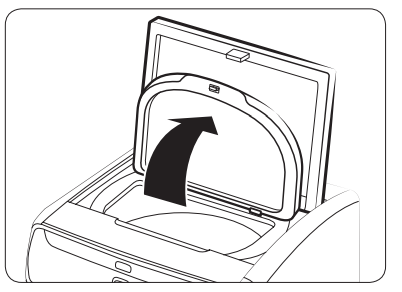
1. Open the top door, and then the protective cover. Remove the Aqua Pebble from the fabric softener container.
2. Put a recommended amount of liquid or powdered detergent into the provided Aqua Pebble. The Aqua Pebble has a guide line (marked ‘20 ml’) near its top, which is the max line. Do not exceed the max line.
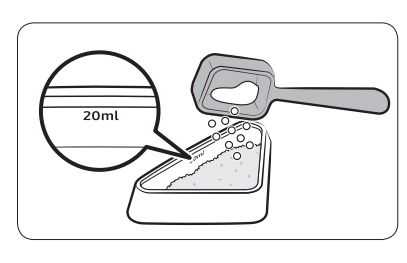
CAUTION
- Any detergent to be added to the upper washer must be put in the provided Aqua Pebble.
- Use HE detergent only.
- If you are adding powdered detergent, use the provided detergent cup, and add only one cup of detergent. Excessive amounts of detergent may cause detergent residue.
- Make sure the powdered detergent you add is a finely ground variety.
- Do not use the Aqua Pebble for bleach and/or fabric softener.
3. Insert the Aqua Pebble around the center of the tub, and then put the laundry over the Aqua Pebble.
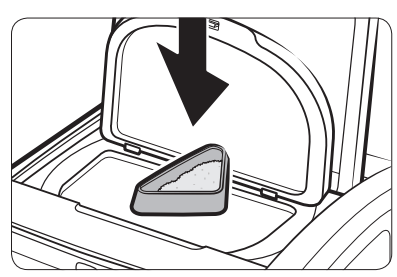
CAUTION: Make sure the Aqua Pebble is input first so it is placed under the laundry. Otherwise, detergent may not dissolve fully, causing residue after the wash is complete.
4. Add a recommended amount of fabric softener to the softener compartment. Do not exceed the max line (A).
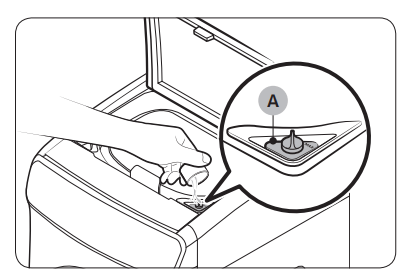

5. Add a recommended amount of liquid chlorine bleach bleach to the bleach compartment. Use caution not to overfill the compartment.
6. Close the protective cover, and then the top door.
NOTE When the cycle is complete, take out the Aqua Pebble, turn it over, and put it on the softener compartment for later use (see the figure). The Aqua Pebble is designed to fit in the softener compartment after it has been turned over.
CAUTION
- Do not use chlorine bleach, which may damage the laundry.
- Use caution when inserting the Aqua Pebble as it is supposed to be balanced on top of the laundry at the beginning of the wash. Tipping the Aqua Pebble before the start of a wash may cause detergent residue to remain on the laundry at the end of the wash, causing discoloration of the laundry and/or reduced washing performance.
- Before each wash, make sure to clean the Aqua Pebble before adding fresh detergent.
- Do not insert the Aqua Pebble into a folded item or between different laundry items.
- Do not use liquid or powdered chlorine bleach.
- Do not put or store cleaning agents such as detergent, bleach, and fabric softener on top of your washer. Wipe up any spills immediately to prevent damage to the washer, especially the finish and the control panels.
NOTE
- It is normal for a small amount of water to remain in the detergent compartments at the end of a cycle.
- When adding color-safe bleach, we recommend you also use liquid detergent.
- When the wash is complete, remove the Aqua Pebble from the tub and clean it so that it is readily available for later use.
Lower washer
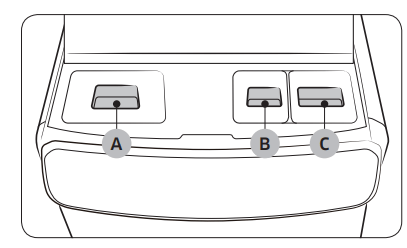
The lower washer provides three cleaning agent compartments: the left-most compartment for the main wash, the rightfirst one for bleach, and the far right for fabric softener.
- Main wash compartment (A): Add a recommended amount of liquid (or powdered) detergent to the main wash compartment.
- Bleach compartment (B): Add chlorine bleach as instructed by the manufacturer.
- Softener compartment (C): Add a recommended amount of fabric softener to the softener compartment.
CAUTION
- Do not use ball or net types of detergent.
- Do not put tablet or capsule types of detergent in the detergent compartment. Tablet or capsule types of detergent must be put directly in the drum.
- To prevent the compartment from clogging, concentrated or highly-enriched agents (fabric softener or detergent) must be diluted with water before being added.
To apply cleaning agents to the lower washer
1. Open the top-front cover.
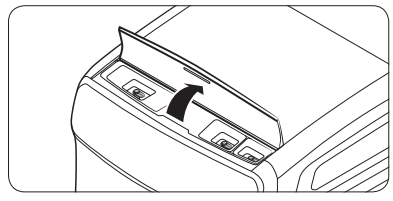
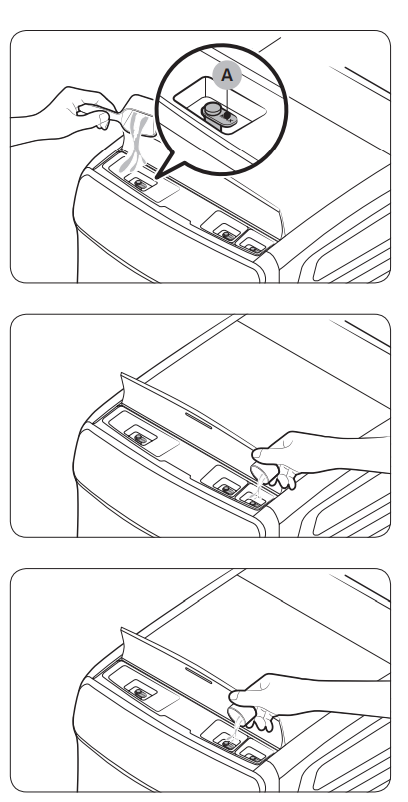
2. Add a recommended amount of liquid or powdered detergent to the detergent compartment. Do not exceed the max line (A). NOTE: To apply powdered detergent, first remove the liquid detergent container.
3. Add a recommended amount of fabric softener to the softener compartment. Do not exceed the max line.
4. If you want to add bleach, add a recommended amount of chlorine bleach to the bleach compartment. Do not exceed the max line.
5. Close the top-front cover.
NOTE
- If you use a high efficiency (HE) detergent, apply 2/3 of the recommended amount to the main wash compartment.
- Oxygen boosters can increase washing performance. Make sure to add the oxygen booster after putting the laundry into the drum.
- To use both powdered detergent and powdered oxygen booster, it is more effective to put them together into the drum before loading the laundry.
Operations
Your dual loading washer features upper and the lower washers for your convenience. The upper washer is an automatic tub loader that is designed to wash relatively small loads while the lower washer is a drum loader that takes care of normal or relatively heavy loads. The main panel is divided into 2 independent control panels.
WARNING: To reduce the risk of fire, electric shock, or injury to persons, read the IMPORTANT SAFETY INSTRUCTIONS before operating this washer.
Upper washer
Control panel

01 Cycle bar Press to select a cycle.
02 POWER Press to turn the upper washer on or off.
03 START/PAUSE (Hold to Start) Press and hold to start operation or press to stop operation temporarily.
04 Status bar The status bar shows current cycle information and estimated time remaining, or an information code if the upper washer needs to be checked.
05 Temp. Press to toggle between two different water temperature options.
- Warm: Colorfast items.
- Cold: Brightly colored, very lightly soiled items.
06 Extra Rinse Use to add an additional rinse at the end of the cycle to remove laundry additives more thoroughly.
07 Self Clean Use to clean dirt and bacteria from the tub. Regular use (after every 20 washes) is recommended. Make sure the tub is empty.
08 Smart Control After connecting the upper washer to your home network using the SmartThings app, you can control the washer remotely. When started, the Smart Control indicator blinks and the top door locks. The washer enters waiting mode and waits for remote commands. For more information, visit the SmartThings app page.
Cycle overview
NORMAL
- For lightly soiled cotton, t-shirts, towels, and mixed loads.
- Use to wash lightly soiled normal items, except delicate fabrics such as silk or handwash-only fabrics.
DELICATES
- For sheer fabrics, bras, lingerie, silks, and other handwash-only fabrics. For best results, use liquid detergent.
ACTIVE WEAR
- For exercise wear such as training pants, shirts/tops, and other performance clothing. This cycle provides effective soil removal with controlled tub rotation for special fabric care.
RINSE+SPIN
- For loads that need rinsing only or for loads you want to add rinse-aided fabric softener to.
- NOTE - Spin Only: This cycle runs a spin cycle only. Press and hold RINSE+SPIN for 3 seconds.
Lower washer
Control panel

01 Cycle area Press to select a cycle.
02 POWER Press to turn the lower washer on or off.
03 START/PAUSE (Hold to Start) Press and hold to start operation or press to stop operation temporarily.
04 Status bar The status bar shows current cycle information and estimated time remaining or an information code if the lower washer needs to be checked.
05 Temp.
- Extra Hot: Heavily soiled, colorfast items. Only available with NORMAL, HEAVY DUTY, SANITIZE and Self Clean+.
- Hot: Whites and heavily soiled, colorfast items.
- Warm: Colorfast items.
- Cool: Brightly colored, very lightly soiled items.
- Cold: Uses only cold water without driving the heater. No warm water is supplied.
06 Rinse
- Press to specify the total number of rinses for the current cycle. Keep pressing to cycle through the rinse count options available. For more information about the options available to a specific cycle, see the Cycle chart
07 Spin
- Extra High: Extends the spinning process to effectively remove moisture from the load. Extra High uses a stronger spinning process to remove moisture, so it is not suitable for wrinklefree or non-iron fabrics, or overloads.
- High: Underwear, t-shirts, jeans, and sturdy cottons.
- Medium: Jeans, wrinkle-free or wash-and-wear items and synthetics.
- Low: Delicate items that require a lower spinning speed.
- No Spin: The drum does not spin after the final drain process.
- Rinse Hold (No lamp turns on): The final rinse process is suspended so that the laundry remains in the water. To unload the laundry, run a drain or spin process.
- NOTE * Spin Only: This cycle runs a spin cycle only. Press and hold Spin for 3 seconds. With the cycle time on the display, press Spin repeatedly until a desired spinning speed is selected. Then, press and hold START/PAUSE to start the cycle.
08 Soil Press the button to select the soil level/washing time.
- Extra Heavy: For extremely soiled loads.
- Heavy: For heavily soiled loads.
- Normal: For moderately soiled loads. This setting is best for
- most loads.
- Light: For lightly soiled loads.
- Extra Light: For barely soiled loads.
09 Pre Soak This adds 30 minutes of soaking time at the start of the wash cycle for better stain removal.
10 Steam With the Steam option selected, the washer senses the weight of the load and controls the steam effect according to the load size. This improves washing performance. Cycles available with the Steam option are: NORMAL, HEAVY DUTY, BEDDING, WHITES, and SANITIZE.
- Select a cycle. For applicable cycles, see above.
- Press Steam.
- Add detergent and fabric softener as instructed.
- Press and hold START/PAUSE to start the cycle. NOTE Steam may not be visible or present during the cycle, which is normal.
11 Super Speed: Press this button if you need to shorten the washing time, applicable for NORMAL, HEAVY DUTY, or BEDDING. The shortened time may differ depending on the selected cycle/load/options.
12 Delay End: You can set the washer to finish your wash automatically at a later time by choosing a delay of between 1 to 24 hours (in 1 hour increments). The hour displayed indicates the time the wash will finish.
- Select a cycle. Then, change the cycle settings if necessary.
- Press Delay End repeatedly until a desired end time is set.
- Press and hold START/PAUSE. The lamp indicator next to the Delay End button turns on with the clock running.
- To cancel Delay End, restart the washer by pressing POWER.
Real-life case: You want to finish a two-hour cycle 3 hours from now. To do this, you add the Delay End option to the current cycle with a 3-hour setting, and then press and hold START/PAUSE at 2:00 p.m. The washer starts operating at 3:00 p.m. and ends at 5:00 p.m. Provided below is the time line for this example.

13 Self Clean+: Cleans the drum by removing dirt and mold from the drum.
- Perform once every 40 washes.
- Make sure the drum is empty.
14 Smart Control: After connecting the lower washer to your home network using the SmartThings app, you can control the washer remotely. When started, the Smart Control indicator blinks and the front door locks. The washer enters waiting mode and waits for remote commands. For more information, visit the SmartThings app page.
Cycle overview
Standard cycles
- DELICATES: For sheer fabrics, bras, lingerie, silks, and other handwash-only fabrics. For best performance, use liquid detergent.
- PERM PRESS:For wash-and-wear, synthetic fabrics, and lightly to normally soiled items.
- TOWELS: For bath towels, washcloths (facecloths) and mats.
- QUICK WASH: For lightly soiled items that you want to finish washing quickly.
- ECO COLD: For normally and lightly soiled items. This cycle uses only cold water to save energy. Cold water also helps prevent fabric damage.
- ACTIVE WEAR: For active wear such as sports jerseys, training pants, shirts/ tops, and other performance clothing. This cycle provides effective soil removal with controlled drum rotation for special fabric care.
- RINSE+SPIN: For loads that need rinsing only or for loads you want to add rinse-aided fabric softener to.
Steam cycles
- NORMAL: For cottons, bed linens, table linens, underwear, towels, or shirts. The washing time and the rinse count are automatically adjusted according to the load.
- HEAVY DUTY: For sturdy, colorfast fabrics and heavily soiled items.
- WHITES: For white items with or without bleach.
- SANITIZE: For heavily soiled, colorfast items. This cycle heats the water to 150 °F to eliminate bacteria.
- BEDDING
- For bulky items such as comforters, blankets, and sheets.
- For best results, wash only a single type of bedding.
- For bulky items, use liquid detergent and do not roll the items when you place them in the drum because they might get stuck.
Simple steps to start
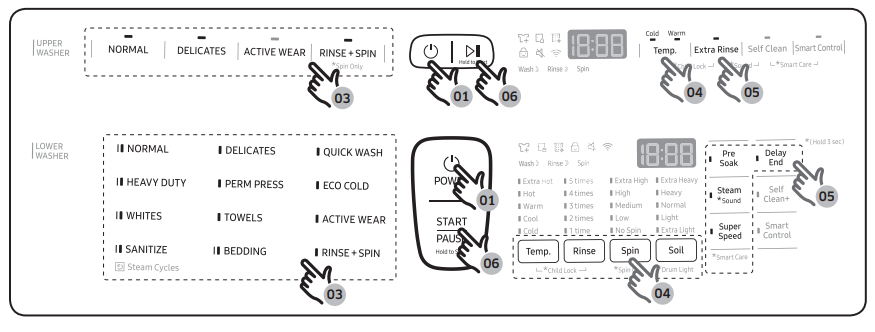
- Press POWER on the control panel of a desired washer (upper/lower) to turn the washer on.
- Put laundry into the washer.
- Select a cycle.
- Change the cycle settings (temperature and/or soil level) as appropriate to the laundry.
- Select cycle options as needed.
- Press and hold START/PAUSE.
To change the cycle during operation
- Press START/PAUSE to stop operations temporarily.
- Select a different cycle.
- Press and hold START/PAUSE again to start the new cycle.
WARNING
- Do not put anything on top of your washer while it is running.
- While the lower washer is operating, the protective cover may have wet steam due to the temperature difference between the upper and lower parts of the washer.
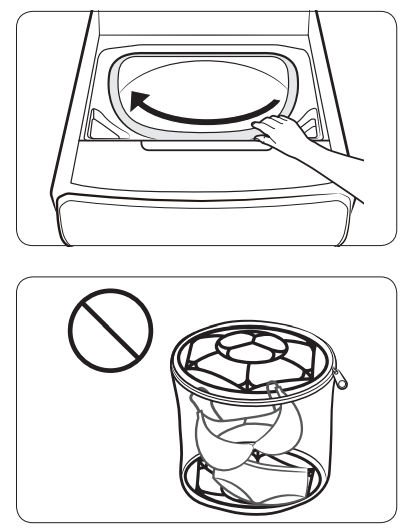
CAUTION: When using the upper washer, you may not see all the remaining clothes after a cycle is finished, especially those in the front area of the tub. When the cycle is complete, turn the tub manually to check if there are any clothes remaining in the tub.
CAUTION: When using the upper washer, do not use a laundry net featuring a protective plastic rim. Otherwise, the net may cause a system failure.
SmartThings
Wi-Fi connection
- On your smartphone, go to Settings and turn on the wireless connection and select an AP (Access Point).
- This appliance supports the Wi-Fi 2.4 GHz protocols.
- Download
- On an app market (Google Play Store, Apple App Store, Samsung Galaxy Apps), find the SmartThings app with a search term of “SmartThings”. Download and install the app on your device.
- NOTE: The app is subject to change without notice for improved performance.
- Log in
- You must first log into SmartThings with your Samsung account. To create a new Samsung account, follow the instructions on the app. You don’t need a separate app to create your account.
- NOTE: If you have a Samsung account, use the account to log in. A registered Samsung smartphone user automatically logs in.
To register your appliance to SmartThings
- Make sure your smartphone is connected to a wireless network. If not, go to Settings and turn on the wireless connection and select an AP (Access Point).
- Open SmartThings on your smartphone.
- If a message of “A new device is found.”, select Add.
- If no message appears, select + and select your appliance in a list of devices available. If your appliance is not listed, select Device Type > Specific Device Model, and then add your appliance manually.
- Register your appliance to the SmartThings app as follows.
- Add your appliance to SmartThings. Make sure your appliance is connected to SmartThings.
- When registration is complete, your appliance appears on your smartphone.
Special features
Child Lock
To prevent children or infants from accidently starting or setting the washer, Child Lock locks all buttons except for the POWER button. Note that each washer operates independently and has its own Child Lock function. If you want to activate Child Lock for the upper or lower washer, you must press the appropriate buttons on the upper or lower washer’s control panel.
To activate Child Lock
- Press and hold Temp. and Rinse (or Temp. and Extra Rinse for the upper washer) simultaneously for 3 seconds. The door locks and the Child Lock indicator turns on. Then, press START/PAUSE to activate.
To deactivate Child Lock temporarily
- You can deactivate Child Lock temporarily for 1 minute. To do this, press and hold Temp. and Rinse (or Temp. and Extra Rinse for the upper washer) simultaneously for 3 seconds. The door is unlocked for 1 minute and the Child Lock indicator blinks.
- NOTE
- If you open the door 1 minute or more after deactivating Child Lock, an alarm sounds for up to 2 minutes.
- If you close the door within 2 minutes, the door locks and Child Lock is reactivated. If you do not close the door or the door is not properly closed, the alarm keeps sounding for 2 minutes.
- To add laundry after activating Child Lock, first deactivate Child Lock or restart the washer.
To cancel Child Lock
- Press and hold Temp. and Rinse (or Temp. and Extra Rinse for the upper washer) for 3 seconds to deactivate, and then press and hold the buttons again for 3 seconds to release Child Lock. The door unlocks and the Child Lock indicator turns off.
Smart Care
The Smart Care function helps you diagnose and troubleshoot your washer if it has an issue. To enable this function, you must first download the Samsung Smart Washer app from the Play Store or the Apple Store, and install it on a mobile device that has a builtin camera. The Smart Care function has been optimized for: Galaxy and iPhone series devices. (It is not supported by some models.)
As the washer operates, it runs self-diagnosis in the background. If it senses an issue to check, it displays an information code on the display which you can scan using the app’s Smart Care function, which then displays detailed information about the code for your reference.
- Press and hold Super Speed (or Self Clean and Smart Control for the upper washer) on the washer for 3 seconds to enter the Smart Care mode.
- Run the Samsung Smart Washer app on your mobile device, and then tap Smart Care.
- Hold the mobile device so that the mobile device and the washer’s status bar face each other. The app will recognize the information code automatically.
- When the information code is recognized correctly, the app provides detailed information about the symptom and recommends further action.
NOTE
- The function name, Smart Care, may differ depending on your language.
- If the washer display is reflecting light, the app may fail to recognize the information code.
- If the app fails to recognize the information code a number of times consecutively, enter the information code manually into the app screen.
- The information code history stored in the washer will be deleted after you use this function.
Sound
- Mute or unmute the sound (button beeps, indicator beeps, and chimes, etc.)
- Upper washer: To mute the alarm sound or beep on the upper washer, press and hold Extra Rinse and Self Clean for 3 seconds. To unmute, press and hold the buttons for 3 seconds again.
- Lower washer: To mute the alarm sound or beep on the lower washer, press and hold Steam for 3 seconds. To unmute, press and hold the button for 3 seconds again.
Drum Light (lower washer only)
- The drum light turns on when the door is opened, and turns off after 2 minutes. To manually turn the drum light on or off, press and hold Soil for 3 seconds.
ATC (Auto Temperature Control)
ATC enables the washer to control water temperatures in each washing cycle using the washer’s internal thermistor. It is designed to maintain certain washing temperatures for best results.
- If you select NORMAL or HEAVY DUTY, you may notice the washer supplying cold water. This is normal because the washer is designed to reduce power consumption.
- In these cycles, the Hot temperature is similar to bath-water temperatures and the Warm temperature to comfortable swimming pool temperatures.
- To wash laundry at a specific temperature, you must choose a different cycle first.
Maintenance
Keep the washer clean for best performance and to lengthen its life cycle.
WARNING: Certain internal parts are intentionally not grounded and may present a risk electric shock only during servicing. Service personnel – Do not contact the following parts while the appliance is energized: Control board, heat sink, motor, inlet valve and pump.
General considerations
Cleaning
Surface of the washer: Use a soft cloth with a nonabrasive household detergent. Do not spray water onto the washer
Exterior
1. Turn off the water taps after finishing the day’s washing. This will shut off the water supply to your washer and prevent the unlikely possibility of damage from escaping water. Leave the lid open to allow the inside of your washer to dry out.
2. Use a soft cloth to wipe up all detergent, bleach, or other spills as they occur. Clean the following as recommended below:
- Control Panel – Clean with a soft, damp cloth. Do not use abrasive powders or cleaning pads. Do not spray cleaners directly on the panel.
- Cabinet – Clean with soap and water.
Interior
- Clean the interior of your washer periodically to remove any dirt, soil, odor, mold, mildew, or bacterial residue that may remain in your washer as a result of washing clothes.
- CAUTION: Failure to follow these instructions may result in unpleasant conditions, including odors and/or permanent stains on your washer or laundry.
- NOTE: Hard water deposits may be removed, if needed. Use a cleaner labeled “Washer safe”.
Mesh filter
Clean the mesh filters in the water inlets once or twice a year.
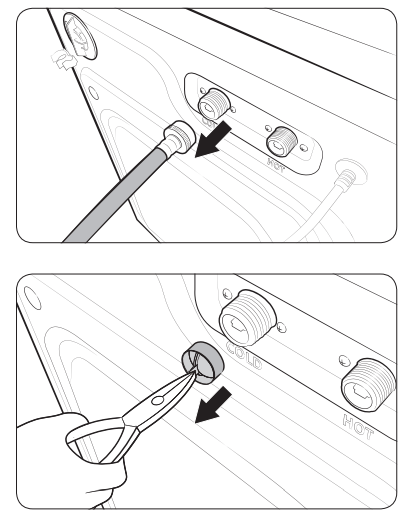
- Turn off the washer, and then unplug the power cord.
- Close the taps.
- Loosen and disconnect the water hose from the back of the washer. Cover the hose with a cloth to prevent water from gushing out.
- Use pliers to pull out the mesh filter from the inlet valve.
- Submerge the mesh filter deeply in water so that the threaded connector is also submerged.
- Dry the mesh filter completely in a shaded area.
- Reinsert the mesh filter into the inlet valve, and reconnect the water hose to the inlet valve.
- Open the tap.
NOTE: If the mesh filter is clogged, the “4C” information code appears on the washer’s display screen.
Recovery from freezing
The washer may freeze when the temperature in its location drops below 32 °F (0 °C).
- Turn off the washer, and then unplug the power cord.
- Pour warm water over the tap to loosen the water hose.
- Disconnect the water hose, and soak it in warm water.
- Pour warm water into the drum (tub) and leave it for about 10 minutes.
- Reconnect the water hose to the tap.
NOTE If the washer still doesn’t operate normally, repeat the steps above until it operates normally.
If the washer will not be used for an extended period of time: Avoid leaving the washer unused for an extended time. If you intend to leave the washer unused for a long period of time, follow the directions below:
- Press POWER, and then select RINSE+SPIN.
- Empty both the drum and the tub, close the door, and then press START/PAUSE.
- When the cycle is complete, close the tap and disconnect the water hoses.
- Turn off the washer, and then unplug the power cord.
- Open the doors to let air circulate through the drum and the tub
Upper washer
Self Clean
Certain usage and environmental conditions may result in some residue build-up or odor in the washer tub. To prevent this build-up of residue or odor causing bacteria and keep your washer tub fresh and clean, perform the Self Clean cycle at least once a month or every 20 cycles. Perform the recommended procedure below when using the Self Clean cycle.
- Remove all items from the washer tub and ensure the tub is empty. Laundry left in the tub during the Self Clean cycle may be damaged.
- Press POWER.
- Press Self Clean.
- Press and hold START/PAUSE.
NOTE:
- The water temperature for Self Clean is defaulted to Hot. This temperature cannot be changed.
- In the case where residue is present in the washer tub, add 1/3 cup (2.7 fl. oz., 80 ml) of liquid chlorine bleach directly to the empty tub before you start the Self Clean cycle. Do not use or mix any other detergent or chemicals during the Self Clean cycle.
- If necessary, run a RINSE+SPIN Cycle after the Self Clean cycle has completed to help remove any remaining residue.
CAUTION
- Check the washer tub before using the Self Clean cycle. Remove any remaining water in the tub by running a Spin Only cycle prior to starting the Self Clean cycle.
- If there is chlorine bleach left in the washer tub for an extended period of time, rust can occur.
Self Clean reminder ( )
)
- After 20 washing cycles, the Self Clean LED reminder icon and the Self Clean cycle LED will blink on the control panel for an hour and then turn off automatically.
- The reminder will appear on the control panel for 5 additional consecutive cycles before turning off. The next reminder will not appear until another 20 cycles have been completed.
Fabric softener/bleach compartment
Both the fabric softener compartment and the bleach compartment on the upper washer are not removable by design to facilitate visual feedback to users. To clean the softener compartment, follow these instructions. Cleaning the bleach compartment is basically the same.
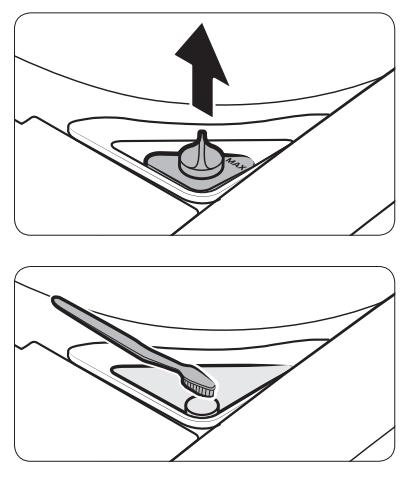
- Open the top door, and then remove the softener cap.
- Use a soft brush (for example, a toothbrush) to clean inside the compartment and remove impurities.
- Run the RINSE+SPIN cycle to rinse the compartment. After supplying water and draining 5 times, the 18-minute cycle completes with the final spin process.
Lint filter
We recommend cleaning the lint filter every 10 washes.

- Remove the lint filter from the filter case on the tub of the upper washer.
- Open the filter, and clean it with running water and a brush.
- When cleaning is complete, close the filter and reinsert it in its original position. You will hear a clicking sound when the filter is inserted correctly
Lower washer
Self Clean+
Certain usage and environmental conditions may result in some residue build-up or odor in the washer drum. To prevent this build-up of residue or odor causing bacteria and keep your washer drum fresh and clean, perform the Self Clean+ cycle at least once a month or every 40 cycles. Perform the recommended procedure below when using the Self Clean+ cycle.
- Remove all items from the washer drum and ensure the drum is empty. Laundry left in the drum during the Self Clean+ cycle may be damaged.
- Press POWER to turn on the washer.
- Press Self Clean+.
- Press and hold START/PAUSE.
CAUTION: If there is chlorine bleach left in the washer drum for an extended period of time, rust can occur.
NOTE
- The water temperature for Self Clean+ is defaulted to Hot. This temperature cannot be changed.
- In the case where residue is present in the washer drum, add liquid chlorine bleach to the MAX level line in the main-wash compartment before starting the Self Clean+ cycle. Do not add the liquid chlorine bleach to the bleach compartment (This is only the case for Self Clean+ cycle). Do not exceed the max line. Do not use or mix any other detergent or chemicals during the Self Clean+ cycle. If necessary, run a RINSE+SPIN Cycle after the Self Clean+ cycle has completed to help remove any remaining residue.
Self Clean+ reminder ( )
)
- After 40 washing cycles, the Self Clean+ LED reminder icon and the Self Clean+ cycle LED will blink on the control panel for an hour and then turn off automatically.
- The reminder will appear on the control panel for 5 additional consecutive cycles before turning off. The next reminder will not appear until another 40 cycles have been completed.
Main wash compartment
The main wash compartment needs to be cleaned periodically to remove buildup of laundry additives.
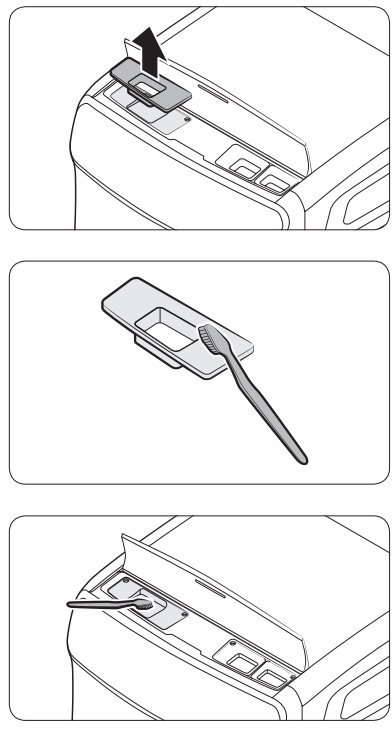
- Open the top-front cover. Grasp the main wash compartment, and then pull up to remove.
- Remove all residue and traces of accumulated laundry agents from the compartment. Rinse it with warm water.
- To clean the recess of the compartment, use a small, non-metal brush. Remove all residue from all sides of the recess.
- Reinsert the compartment into place.
Fabric softener/bleach compartment
Both the fabric softener compartment and the bleach compartment on the lower washer are not removable by design to facilitate visual feedback to users. To clean the softener compartment, follow these instructions. Cleaning the bleach compartment is basically the same
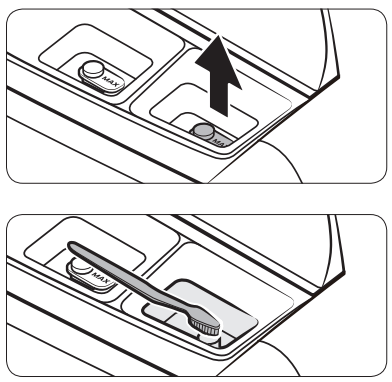
- Open the top-front cover, and then remove the softener cap.
- Use a soft brush (for example, a toothbrush) to clean inside the compartment and remove impurities.
- Run the RINSE+SPIN cycle to rinse the compartment. After supplying water and draining 5 times, the 19-minute cycle completes with the final spin process.
Door diaphragm
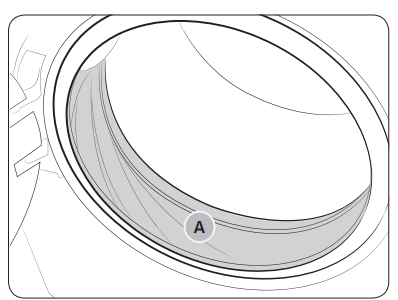
- Open the door and empty the drum.
- Turn out the diaphragm (sealing or gasket of the drum (A)), and check if it is stained. If so, follow the steps below.
- Combine 3/4 cups of liquid chlorine bleach and 1 gallon of warm tap water.
- Wearing rubber gloves, use a soft, clean cloth dipped in the water and chlorine solution to clean the diaphragm.
- Let stand for 5 minutes, and then wipe up and dry well.
CAUTION: Use bleach carefully and be sure to follow the bleach manufacturer’s use and care instructions
Emergency drain
In case of a power failure, drain the water inside the drum before taking out the laundry.
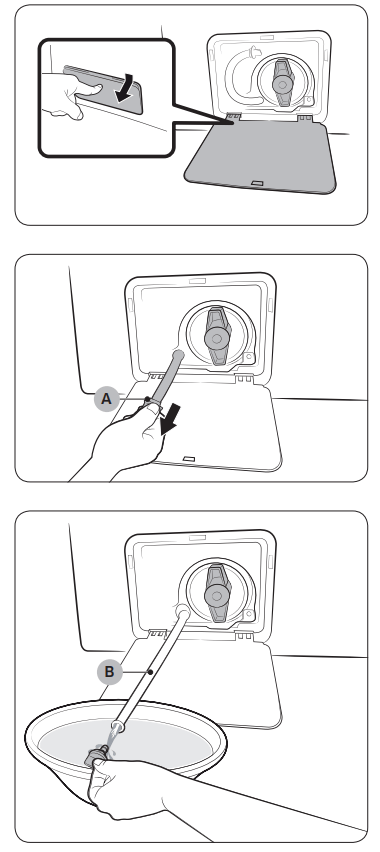
- Power off the washer, and then unplug it from the electrical outlet.
- Gently press the top area of the filter cover to open.
- Put an empty, spacious container in front of the cover, and stretch the emergency drain tube to the container while holding the tube cap (A).
- Open the tube cap and let water in the Emergency drain tube (B) flow into the container.
- When done, close the tube cap, and reinsert the tube. Then, close the filter cover. NOTE Use a spacious container because the water in the drum may be more than expected.
Pump filter
It is advisable to clean the pump filter 5 or 6 times a year to prevent it from clogging. A clogged pump filter may reduce the bubble effect.

- Turn off the washer, and then unplug the power cord.
- Drain the remaining water inside the drum. See the Emergency drain section
- Gently press the top area of the filter cover to open.
- Turn the pump filter knob (A) to the left, and drain off the remaining water.
- Clean the pump filter using a soft brush. Make sure the drain pump propeller inside the filter is not clogged.
- Reinsert the pump filter, and then turn the filter knob to the right.
- Close the filter cover.

NOTE
- Some pump filters feature a safety knob that is designed to prevent children from accidently opening the filter compartment. To open the safety knob of the pump filter, push in and turn it counterclockwise. The spring mechanism of the safety knob helps open the filter.
- To close the safety knob of the pump filter, turn it clockwise. The spring makes a rattling sound, which is normal.
NOTE: If the pump filter is clogged, the “5C” information code appears on the washer’s display screen.
CAUTION
- Make sure the filter knob is closed properly after cleaning the filter. Otherwise, this may cause a leak.
- Make sure the filter is inserted properly after cleaning it. Otherwise, this may cause an operational failure or a leak.
Troubleshooting
Checkpoints
If you encounter a problem with the washer, first check the table below and try the suggestions.
1. Does not turn on.
- Make sure your home electrical system is providing electrical power that matches the requirements of the washer.
- Make sure the power plug of the washer is completely plugged in.
2. Does not start.
- Make sure the door is properly closed.
- Make sure the taps are open.
- Make sure to press and hold START/PAUSE to start the washer.
- Make sure Child Lock is not activated.
- Before the washer starts to fill, it will make a series of clicking noises to check the door lock and does a quick drain.
- Check the fuse or reset the circuit breaker.
- Check if the upper or lower washer displays an information code on the respective status bar.
3. Water supply is insufficient or no water is supplied
- Fully open the tap.
- Make sure the door is properly closed.
- Make sure the water supply hose is not frozen.
- Make sure the water supply hose is not kinked or clogged.
- Make sure there is sufficient water pressure.
4. After a cycle, detergent remains in the detergent drawer.
- Make sure the washer is running with sufficient water pressure.
- If you are using powdered detergent, do not use more than recommended.
- If you are using liquid detergent, do not over fill the liquid detergent compartment.
- Remove the liquid detergent and softener containers, and then clean the detergent drawer.
5. Excessive vibrations or makes noise
- Make sure the washer is installed on a level, solid floor that is not slippery. If the floor is not level, use the levelling feet to adjust the height of the washer.
- Make sure the shipping bolts are removed.
- Make sure the washer is not contacting any other object.
- Make sure the laundry load is balanced.
- The motor can cause noise during normal operation.
- Overalls or metal-decorated clothes can cause noise while being washed. This is normal.
- Metal objects such as coins can cause noise. After washing, remove these objects from the drum or tub or filter case
6. Does not drain and/ or spin.
- Make sure the drain hose is neither kinked nor obsructed all the way to the drain system. If there is a drain restriction, call for service.
- Make sure the debris filter is not clogged.
- Close the door and press and hold START/PAUSE. For your safety, the washer will not tumble or spin unless the door is closed.
- Make sure the drain hose is not frozen or clogged.
- Make sure the drain hose is connected to a drain system that is not clogged.
- If the washer is not supplied with sufficient power, the washer temporarily will not drain or spin. As soon as the washer regains sufficient power, it will operate normally
7. Drains with noise.
- At the initial installation, or when the washer has not been used for an extended period of time, the washer may make deflating noises while draining. This is not a system failure.
8. The door does not open.
- Press START/PAUSE to stop the washer.
- It may take a few moments for the door lock mechanism to disengage.
- The door will not open until 3 minutes after the washer has stopped or the power has been turned off.
- Make sure all the water in the drum or tub is drained.
- The door may not open if water remains in the drum or tub. Drain the drum or tub and open the door manually.
- Make sure the door lock light is off. The door lock light turns off after the washer has drained.
9.Excessive suds.
- Make sure you use the recommended types of detergent.
- Use high efficiency (HE) detergent to prevent oversudsing.
- Reduce the detergent amount for soft water, small loads, or lightly soiled loads.
- Non-HE detergent is not recommended.
10. Cannot add additional detergent.
- Do not fill the detergent or fabric softener compartments beyond the marked max fill limit.
11. The washer stops.
- Plug the power cord into a live electrical outlet.
- Check the fuse or reset the circuit breaker.
- Close the door, and then press and hold START/PAUSE to start the washer. For your safety, the washer will not tumble or spin unless the door is closed.
- Before the washer starts to fill, it will make a series of clicking noises to check the door lock and does a quick drain.
- There may be a pause or soak period in the cycle. Wait and the washer may start.
- Make sure the mesh filters of the water supply hoses at the taps are not clogged. Periodically clean the mesh filters.
- If the washer is not supplied with sufficient power, the washer temporarily will not drain or spin. As soon as the washer regains sufficient power, it will operate normally.
12. The washer fills with the wrong temperature water.
- Fully open both taps.
- Make sure the temperature selection is correct.
- Make sure the hoses are connected to the correct taps. Flush the water lines.
- Make sure your water heater is set to supply hot water with a minimum temperature of 120 °F (49 °C) at the tap. Also, check the water heater capacity and recovery rate.
- Disconnect the hoses and clean the mesh filters. The mesh filters may be clogged.
- While the washer fills, the water temperature may change as the automatic temperature control feature checks the incoming water temperature. This is normal.
- While the washer fills, you may notice just hot and/or just cold water going through the dispenser when cold or warm temperatures are selected. This is a normal function of the automatic temperature control feature as the washer determines the water temperature.
13.The load is wet at the end of a cycle.
- Use the High or Extra High spin speed.
- Use high efficiency (HE) detergent to reduce oversudsing.
- The load is too small. Small loads (one or two items) may become unbalanced and not spin completely.
- Make sure the drain hose is not kinked or clogged.
14. Leaks water.
- Make sure the door is properly closed.
- Make sure all hose connections are tight.
- Make sure the end of the drain hose is correctly inserted and secured to the drain system.
- Avoid overloading.
- Use high efficiency (HE) detergent to prevent oversudsing.
15. Has odors
- Excessive suds collect in recesses and can cause foul odors.
- Run cleansing cycles to sanitize periodically.
- Clean the door seal (diaphragm).
- Dry the washer interior after a cycle has finished.
16. The tub or the water/ drain hose is frozen.
- For frozen hoses, use warm water to disconnect the frozen hoses. Soak them in warm water.
- For a frozen tub, fill the tub with warm water, and then wait for about 10 minutes.
- For the hose connector, put a hot towel on the drain hose connector.
- After thawing the hoses, reconnect them.
17. Water drains out immediately.
- Make sure the drain hose is not clogged, and is hung over the drain hose hook. Fill the tub halfway with water, and try spinning again.
- Lift the end of the drain hose to prevent water from draining. Fill the tub halfway with water, and then run the spin cycle after releasing the drain hose.
- Make sure the drain hose is installed correctly. See the installation section of this manual and then adjust the position of the drain hose as instructed.
- Make sure the washer drains completely if it is turned off by force. If you operate the washer before it has drained completely, the washer may supply water and drain simultaneously.
If an issue continues to occur, contact a local Samsung service center.
Information codes
If the washer fails to operate, you may see an information code on the screen. Check the table below and try the suggestions.
1. Upper washer 1 1C
Lower washer 1C
- Check the water level sensor.
- Power off and then power the washer on after 2-3 minutes, and then try again.
- Depending on the model, the drain system drains water automatically. The POWER and START/PAUSE buttons may be disabled during this process.
2. Lower washer: dC - The door is open.
- Close the door, and then press START/PAUSE to resume operation
3. Upper washer: 1 dC
- The top door is open.
- Close the top door, and then press START/PAUSE to resume operation.
4. Upper washer: 1 dC4
- The protective cover is open.
- Close the protective cover, and then press START/PAUSE to resume operation
5. Upper washer 1 dC1
Lower washer dC1
- Check the door switch.
- Power off and then power the washer on after 2-3 minutes, and then try again
6. Upper washer 1 LC
Lower washer LC
- Check for water leaks.
- Power the washer off, and then check the drain system for any leaks. Once the leak issue is resolved, power the washer on after 2-3 minutes.
- Depending on the model, the drain system drains water automatically. The POWER and START/PAUSE buttons may be disabled during this process.
7. Upper washer 1 LC1
Lower washer LC1
- Check the drain hose.
- Make sure the end of the drain hose is placed on the floor.
- Make sure the drain hose is not clogged.
- If the information code remains, contact a customer service centre.
- Others
- Use caution not to overfill any of the compartments (main wash/fabric softener/bleach).
- Do not spray or use water when cleaning the top door of the upper washer. Use a cloth to wipe up.
8. Upper washer 1 4C
Lower washer 4C
- Check the water supply line.
- Check the connection to the water line (including water taps).
- Power off and then power the washer on after 2-3 minutes, and then try again.
- Depending on the model, the drain system drains water automatically. The POWER and START/PAUSE buttons may be disabled during this process.
9. Upper washer 1 4C2
Lower washer 4C2
- The water being supplied is too hot.
- Make sure the cold and hot water taps are properly connected.
- Power off and then power the washer on after 2-3 minutes, and then try again.
10. Upper washer 1 5C
Lower washer 5C
- Check the drain system.
- Make sure the drain filter is not clogged.
- If the drain filter is clogged, clean the filter, and then restart the washer.
11. Upper washer 1 HC
Lower washer HC
- Check the washing heater.
- Power off the washer, and then contact a Samsung customer service center.
12. Upper washer 1 UB
Lower washer UB
- Check the spinning process.
- The load may not be balanced inside the drum or tub. Load is too small, or heavy items are mixed with light items. Check the drum or tub and make sure the load is balanced.
- Avoid washing single items, adding few extra items help to balance the load. Redistribute the load evenly.
- Press START/PAUSE to resume operation, or power off and then power the washer on after 2-3 minutes, and then try again.
13. Upper washer 1 8C 1 8C1 1 8C2
Lower washer 8C 8C1 8C2
- Check the MEMS sensor.
- Power off and then power the washer on after 2-3 minutes, and then try again.
14. Upper washer 1 OC
Lower washer OC
- Water may overflow.
- Close the water tap, and then call for service.
15. Upper washer 1 3C
Lower washer 3C
- Check the motor.
- Power off and then power the washer on after 2-3 minutes, and then try again.
16. Upper washer 1 3C
Lower washer
1 AC6 AC6 Check the PBA communication status. • Power off and then power the washer on after 2-3 minutes, and then try again.
17. Upper washer 1 9C1; 1 9C2
Lower washer 9C1 ; 9C2
- The electronic control needs to be checked.
- Check if power is supplied properly.
- If the information code remains, contact a Samsung service center.
18. Upper washer 1 SF
Lower washer SF
- System failed.
- Power off the washer, and then contact a Samsung service center.
19. Upper washer 1 AC
Lower washer AC
- Check communications between main and sub PBAs.
- Try powering off and restarting the cycle.
- If the information code remains, contact a customer service center.
20. Lower washer: AC7
- Check communications between the lower main PBA and the upper main PBA.
- Try powering off and restarting the cycle.
- If the information code remains, contact a customer service center.
Specifications
Protecting the environment
- This appliance is manufactured from recyclable materials. If you decide to dispose of it, please observe local waste disposal regulations. Cut off the power cord so that the appliance cannot be connected to a power source. Remove the lid so that animals and small children cannot get trapped inside the appliance.
- Do not exceed the detergent quantities recommended in the detergent manufacturers’ instructions.
- Use stain removal products and bleaches before the wash cycle only when necessary.
- Save water and electricity by only washing full loads (the exact amount depends upon the program used).
Specification sheet
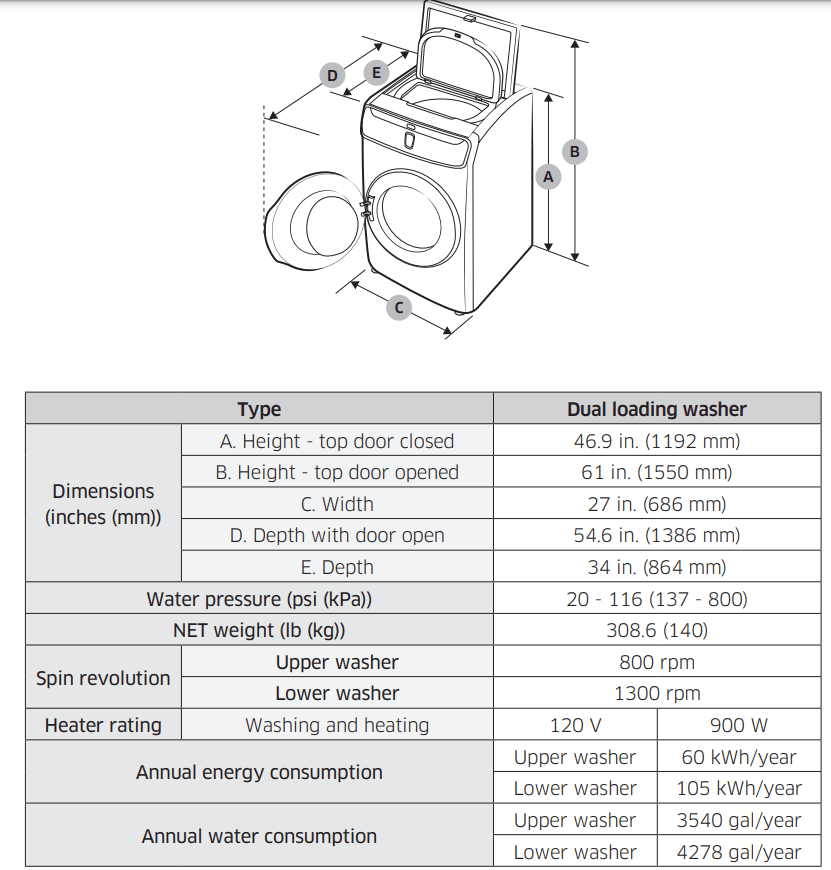
See other models: WA52M7750AV/A4 WF45K6500AV/A2 WF50K7500AV/A2 WF42H5000AW/A2 WF45N5300AV/US
